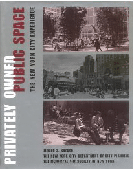
1221 Sixth Avenue
McGraw-Hill
The two McGraw-Hill public spaces are in the middle of the Sixth Avenue row of three colossal plazas between West 47th and 50th Streets. Together with the plazas at 1211 Sixth Avenue and 1251 Sixth Avenue, the spaces evoke significant urban planning questions explored in this book’s profile of the 1251 Sixth Avenue plaza as well as in Chapter 3. The McGraw-Hill spaces in their broad layout and relationship to the building footprint are twins of the space at 1251 Sixth Avenue. The building is set back significantly from the street, creating a large open area, and the building is recessed on its sides to create the opportunity for additional space to the west. Behind the building is a through-block space not legally required to be public but nonetheless made publicly accessible in the past by the owner.

What distinguishes McGraw-Hill, however, is its sunken plaza, one of only three required outdoor public spaces with sunken areas remaining in the City’s public space inventory; the others are located at Paramount Plaza and the Citigroup Center. At the time of this writing, the sunken plaza in front of the General Motors Building at Trump International Plaza is being eliminated. Interestingly, the McGraw-Hill sunken space did not qualify for or generate a floor area bonus under the 1961 Zoning Resolution’s “as-of-right” plaza standards because it violated, by inches, the prohibition against plazas more than 12 feet below street level. Nonetheless, the developer obtained a City special permit granting a waiver from height and setback rules for its building, which obligated it to construct the development shown on submitted and approved plans, including this sunken plaza.
The top of a 50-foot-tall polished stainless steel sculpture, entitled The Sun Triangle (1973), by Athelstan Spilhaus, pierces the imaginary street-level horizontal plane. Stairs at north and south corners provide access to the base of the sculpture. The three sides of the triangle point to the four seasonal positions of the sun at solar noons. Nearby, circular decals inscribed in the granite floor elaborate on a planetary theme. Tucked against the southern stairwell is limited bench seating. Chairs and tables for a adjacent restaurant have replaced a reflecting pool and fountain. No record of City approval for this restaurant use has been found. The restaurant, an entry to a theater, and connections to the subway and Rockefeller Center’s underground concourse create traffic through the space, and some of the pedestrians stop at the bench seating during summer months.
The plaza at street level includes elevated terraces at north and south ends, similar to those at 1251 Sixth Avenue, with trees and benches overlooking the sunken plaza. Planters and planter benches are also located next to the building’s primary entrance on West 49th Street. When it is open, the non-required, uncovered, through-block corridor at the back of the building doubles as a pleasant lunch spot as well as the third link in an informal, non-required, four-block pedestrian chain. The West 48th Street entrance is guarded by a concrete wall, parted by a cylindrical glass tunnel entry featuring water spilling overhead and down the curving glass sides. This contemporary evocation of Moses and the Red Sea leads not to the promised land, but to an area with fixed bench seating, movable tables and chairs, small fountain and pool, exotic plants hanging on a trellis, and food service closer to West 49th Street.




The sunken plaza and both raised platforms beside it were closed off Sunday, April 27th.
Thank you for bringing this to the attention of the public. It is “your” eyes on the street that help keep public space public. Ideally there would be an ongoing, proactive monitoring program. For the moment, resources in public and private sectors have not been up to this task.